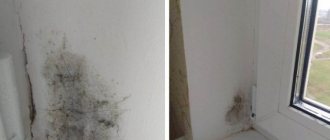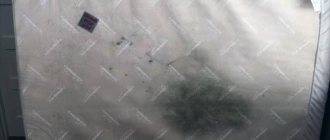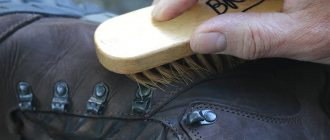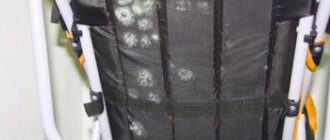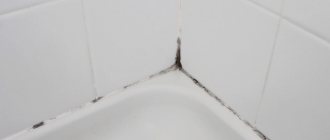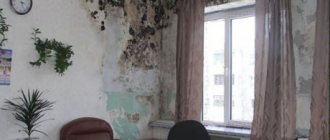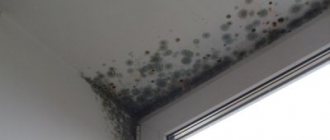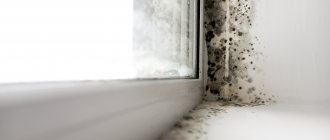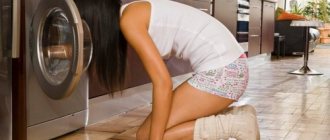Photo: AP Archive
We destroy without compromise
Getting rid of mold is not an easy task. But this needs to be done as quickly as possible.
“Mold multiplies at an incredible speed, capturing nearby surfaces: in a small area, the number of fungi actively forming new spores quickly reaches several billion,” warns Olga Nenya, biologist at the disinfection department of the Center for Hygiene and Epidemiology in the Amur Region. — Mold spores are everywhere. Even in a relatively clean room, one cubic meter of air can contain up to 500 spores, which settle on the surface of objects and then germinate under favorable conditions. For the development of most mold fungi, air humidity is about 70 percent and temperature is from 20 to 35 degrees. In 24 hours, the mass of an Aspergillus fumigatus colony can increase 9 times!
This is a genus of black molds that scientists have nicknamed “Tutankhamun’s Curse.” And to meet their varieties, there is no need to look into the ancient tombs of the Egyptian pharaohs. “Black rot” can also appear in our bathtubs, basements, and on the walls of houses, especially after flooding. As soon as we make a mistake, mold will immediately take advantage of this - it will penetrate our body and try to destroy it.
What are the dangers of “household” fungus?
Not everyone knows how dangerous mold colonies are. Short-term contact does not pose a threat to health, but if the walls are covered with yellow or black fluffy “moss” and you live with it for years, then such proximity will affect all family members. And especially on children!
Irina Zhidkova, a doctor at the Amur Regional Center for Medical Prevention, has worked a lot in pulmonology. And among her patients with asthma and chronic respiratory diseases, there were those whose primary cause of illness was the presence of mold in the house.
In a room with too high a moisture level, plastic windows can further contribute to the rapid development of fungus.
As the mold develops, it is capable of releasing thousands of spore embryos. Microorganisms, which are the strongest allergen for the human body, dry out and turn into dust, and then fall to the floor or mix with the air. This way they get on our skin, on the mucous membranes of the nasopharynx, in the bronchi and even in the lungs.
Human immunity, exposed to constant exposure to mold, slowly but surely fades away. Children's diathesis, allergies in various forms, turning into asthma, mycoses, rhinitis, liver and gastrointestinal diseases, and even cancer can be a consequence of the fact that a person lives next to mold. Doctors unanimously declare the danger of mold in houses and apartments. They say: if you don’t catch it in time, you can remain disabled for life.
First we clean and dry the house
“Everyone is fighting mold, although we need to fight dampness,” says famous comedian Mikhail Zhvanetsky. Indeed, when the water has gone, the first step is to take measures to dry the house and underground. There is no need to carry out any mold treatment on damp walls.
- If there is still water in the underground, it needs to be pumped out, and then the house can be dried. Standing water in a crawl space provides an ideal breeding ground for microorganisms such as viruses, bacteria and mold. But first, you need to clear the house as much as possible so that there is no household garbage or clutter left anywhere, advises Ekaterina Burdinskaya, deputy chief physician of the Center for Hygiene and Epidemiology in the Amur Region. - Clothes, furniture, carpets - everything needs to be taken outside, under awnings, and the house itself must be dried with a cannon. Just don’t hang anything on the cannons or place them very close to avoid fires. If you can’t dry anything quickly, you need to make a strong-willed decision and simply throw away some of the damaged items. It is not advisable to store and store wet carpets and things somewhere - this is a breeding ground for mold fungi. In Rus', huts infected with fungus were often simply burned so that the mold fungus did not spread to neighboring buildings.
Another piece of advice from epidemiologists: you need to remove mold from walls efficiently. Carefully scrape out the wooden supports in the cellar, clean the damaged areas with a spatula, sandpaper, iron brush or drill with a coarse attachment. If the water has stood in the house for a long time and during the cleaning process you see that the fungus has penetrated deep into the structure of the wood, this is a death sentence. The entire board or log must be replaced. In case of certain difficulties, the affected piece is cut out in a beam or log with a “small margin” and a new one is inserted. During work, it is imperative to protect your mouth, nose and eyes - work with gloves, safety glasses and a respirator to prevent mold spores from entering the body.
Treated with antifungal agents
The area of walls affected by mold matters. If the area is small, then the antifungal solution can be diluted during treatment, but if it is large, then the solution should be more concentrated. Read the instructions carefully. There is no need to rinse treated walls with water. You can immediately begin decorating the room.
Folk remedies for mold also work, experts say. The simplest thing is salt. The area affected by the fungus is first cleaned to the ground, and then everything is treated with a strong saline solution. This method is used in baths, periodically covering the floor with salt for prevention.
“I use bleach, and my brother adds formalin,” says Igor Melnik, a resident of the Mazanovsky district, whose house has experienced more than one flood. - This “napalm” helps against fungus. Or I treat the underground with copper sulfate. The correct name is copper sulfate. You can prepare the following “cocktail”: per liter of water, 50 grams of vitriol plus 100 grams of potassium alum (a drug used in medicine) and add 30 grams of table salt. After you have thoroughly cleaned everything, carefully use a roller or brush to work the area where the mold was.
If the mold is fresh, then, according to people’s reviews, “Beliza”, sold in hardware stores, is quite effective. Just be careful: never mix bleach with ammonia or detergents containing ammonium, as this can create dangerous gases.
- In case of extensive fungal infection of walls, floors or cellars, folk remedies are no longer enough. You definitely need to purchase antifungal drugs in a specialized store, and after 10 days the treatment of the premises must be repeated, advises Olga Nenya. “And the best solution for severe mold infestations is to call a mold remediation professional to your home.
“You need to fight mold before the cold weather!”
Ekaterina Burdinskaya, deputy head physician of the Center for Hygiene and Epidemiology in the Amur Region:
— The main thing is not to delay antifungal work. It happens that the plot is flooded, people leave, and then return and start gardening: “When we dig up the potatoes in September, we’ll do everything.” No! Mold needs to be dealt with now. Antifungal work is effective when the daily temperature is from +5 to +30 degrees.
Olga Nenya, biologist of the disinfection department of the Center for Hygiene and Epidemiology in the Amur Region:
— If the owners destroyed the fungus for the first time, but high humidity remains in the room, then after 10 days the fungus begins to develop again. Therefore, the first thing to do is to reduce the humidity of the room, and after 10 days repeat the anti-mold disinfection. Do not place furniture in rooms close to the walls - there is a high probability of condensation due to poor ventilation. And wipe the washed dishes dry, then dampness will not appear in the kitchen cabinets.
The Center for Hygiene and Epidemiology in the Amur Region operates a hotline number - (4162) 596-898. Disinfection department specialists give advice on what products to use to combat mold.
Will ultraviolet help prevent mold?
— What I saw on sale were portable devices for home use for the purpose of physiotherapy for the oropharynx and nasopharynx, “Sun” type devices. Yes, in the instructions for use the manufacturer writes that it is possible to remove the attachments for open radiation. But it is impossible to say that this will be effective in combating mold, says Ekaterina Burdinskaya. — But natural solar insolation is very good. Many people like to shade their apartments, but they need to open the curtains wide and raise the blinds so that sunlight can easily penetrate into the room for at least three hours every day.
Age category of materials: 18+
- Irina Voroshilova
- Amurskaya Pravda from 08/08/2019
Harm from mold
Mold in the apartment is a common occurrence. It poses a danger to human health due to the toxic fumes produced by many types of fungus and their spores. In just one square meter, mold produces millions of spores every day, they settle on surfaces and begin to actively develop. What will happen if she stays on the wallpaper in the apartment for several months?
Moreover, spores can enter the human body through the skin, nose and mouth. In contact with the skin, the fungus can cause many diseases; it is for this reason that to visit the pool you need a certificate confirming the absence of fungus on the skin and nails. If during the brushing procedure you notice an unpleasant taste and smell of mold, it means that the toothbrush is a carrier of fungus, so it is recommended to immediately replace the accessory. A more common reaction of the body is an allergy, which especially often affects children and the elderly. Depending on susceptibility, the severity of the disease may vary.
What is the effect of indoor dampness?
As already noted, high humidity leads to damage to finishing materials and interior items. Products made from paper, wood or leather are especially affected. Even door blocks can become deformed, and paintings and books can become unusable. All this leads to the need for repair work.
But most importantly, dampness can cause irreparable harm to the health of household members. Young children and elderly residents are most at risk. Spores of harmful microorganisms lead to exacerbation of chronic diseases. Once in the respiratory system, they cause allergic reactions.
Dampness can cause irreparable harm not only to the surfaces of walls, floors and ceilings, but also to health
Much more often, apartment residents suffer from colds, and they occur in a more acute form. Damp textiles in contact with the body contribute to the development of rheumatism.
Symptoms associated with mold and moisture in the home may include wheezing, runny nose, morning cough, eczema
It becomes uncomfortable to be near the apartment. People's concentration decreases, fatigue appears, and problems with performance arise. The unpleasant smell coming from clothes also does not add positive emotions. Finally, food shelf life is reduced.
Diseases
The most common diseases in the presence of dampness and mold in the apartment are: bronchial asthma, skin rashes, pneumonia, sinusitis, gastrointestinal disorders, nosebleeds, headaches.
Many types of mold that are common in the CIS countries are pathogenic forms. Mold in the corners, on the ceiling, in the bathroom - long-term contact can lead to such serious pathologies as liver and kidney damage, emphysema.
Factors indicating a problem
It is possible to determine a significant excess of the humidity level in an apartment not only using a special device, but also visually.
Mold and mildew appear on the ceiling or walls. Microorganisms multiply at lightning speed in a confined space when the moisture content in the air exceeds 70% and the ambient temperature exceeds 18 degrees.
Mold on the walls
Symptoms of dampness include problems with the condition of the finish: plaster may fall off, wooden materials may rot, or wallpaper may come off the walls.
Condensation appears on plastic windows. The reason may be either manufacturing defects in the structures or problems with the microclimate in the apartment.
Condensation on plastic windows
In addition to the listed problems from dampness in the room, for those in the apartment discomfort will also be caused by an unpleasant odor, which cannot be eliminated with the help of any air fresheners.
Reasons for appearance
Fungal spores are found everywhere, in water and air, and once in an environment favorable to them, they begin to grow rapidly. The fungus especially loves insufficient ventilation and high humidity. “Damp” premises, apartments located next to basements, improper use of humidifiers, a lot of all kinds of indoor plants - this can lead to the destruction of mold in the apartment .
Among the finishing and building materials, regardless of their cost, it is perhaps impossible to find one that is not susceptible to the formation of fungus. It can often be found in toilets, bathrooms, refrigerators, and washing machines. Mold also often forms on the ceiling in an apartment.
The main sign of the appearance of fungus is an unpleasant smell of pungency and dampness. Then spots of whitish, black and gray shades appear.
Who will pay for mold removal after a flood?
Copper sulfate and drying with infrared heaters and lamps do not give reliable results. Antifungal treatment using multi-stage technology from specialized services is required. Their services are not cheap, nor are new repairs. You can recover funds for these needs from the guilty party: neighbors or the management company that allowed the flooding.
The PRO Bay team is ready to help with individual services or run a turnkey business. The secretary will coordinate the interaction of the disputing parties (agree on the date of the inspection, etc.). Expert appraisers will inspect the premises and draw up an expert opinion - strong evidence in court. Lawyers will prepare a pre-trial claim, claim, and achieve payment. The couriers will deliver the writ of execution to the person responsible for the leak. Payment for our services is made after receipt of money to the client's account.
How to get rid of mold
How to get her out of the apartment if she has already appeared? First of all, the problem of ventilation and high humidity should be solved. Otherwise, no matter what you do, it will appear again and again.
Deliverance requires an integrated approach. It is not enough to scrape off and wash off the fungus; it is necessary to create a certain microclimate in which mold cannot develop.
Basic measures to eliminate mold in an apartment:
- It is necessary to mechanically clean the flooring, ceiling, walls, all cracks where there is mold;
- Treat the affected surfaces with a special product;
- Get rid of things that have become unusable;
- Regularly ventilate the room and maintain an optimal humidity level.
Advice: if wallpaper, upholstered furniture and other products made of porous material are affected by mold, you should not try to clean it, it is better to replace them with new ones.
Mold after flooding: nuances
- Fungi are easy to see on open surfaces (walls, corners). However, colonies often “hide” under wallpaper, suspended ceilings, and wall panels, where air circulation is difficult.
- The damage does not appear immediately: before mold is detected after an apartment has been flooded, it can take from 2 weeks to several months after the fact of the flood.
- To prove the connection, it is necessary, upon discovering a leak, to immediately call the management company and draw up a flooding report. An examination will help prove the extent of the damage and the cause.
Means of struggle
After the mandatory measures described above, it is necessary to treat the room with special antiseptic agents, which can be found on store shelves without much difficulty.
Important! Any preparation for cleaning fungus contains a lot of chemicals and is poisonous for humans. Therefore, work with them as carefully as possible, first protecting your hands with rubber gloves. And before you start, carefully read the instructions.
Antiseptic primer
You can get rid of mold using a special antiseptic primer. The product can be purchased at any building materials store. The primer will solve several problems at once: it will destroy mold and also prevent its occurrence in the future.
The primer is easy to use and often does not need to be diluted with water. However, when working with the product, it is recommended to strictly follow the instructions.
Before applying the product, the surface is cleaned until the top layer of plaster is removed. Apply the primer to a dry wall with a simple paint brush, and after drying you can begin wallpapering or painting.
Bleach
Using home remedies that are likely to be found in every housewife’s home, you can also eliminate mold in your apartment. For example, bleach, which is no less effective than an antiseptic primer.
Thanks to bleach, the main active ingredient of which is sodium hypochlorite, you can clean any type of fungus, including its spores. The product is easy to clean bathroom tiles, mirrors, glass and floor coverings.
Important! When using bleach, be careful - many things can lose their original color.
And you need to use it with rubber gloves, since chlorine corrodes the skin of your hands. In addition, the room should be thoroughly ventilated after treatment. Whiteness is diluted in a ratio of 1:10.
Vinegar
You can also fight mold with vinegar, which is an acid and therefore can eliminate the fungus and prevent its further development. Vinegar has a specific odor, but unlike bleach, it does not emit toxic substances. It is applied to damaged surfaces using a spray and wiped with a damp cloth. After keeping the solution for about an hour, the surface is treated with water. As a preventive measure, it is recommended to carry out the procedure weekly.
Hydrogen peroxide
Fungus in the apartment can be cleaned with hydrogen peroxide, which is an antibacterial and antifungal drug. The hydrogen peroxide solution is non-toxic and does not emit harmful substances. The product is suitable for removing mold from many materials, but has a bleaching property.
Ammonia
Ammonia can destroy fungus on non-porous and non-solid materials, such as glass and tiles.
The product is diluted with water 1:1 and the resulting solution is sprayed on the walls. After several hours, rinse thoroughly with water.
Attention! The unpleasant smell of ammonia can cause severe headaches and a sore throat. It is forbidden to mix ammonia with bleach, as this mixture emits toxic gases!
Baking soda
Mold after flooding in an apartment or in any other case can be removed with baking soda. It destroys fungal spores, but unlike other products, it is a safe and natural household cleaner and will not harm humans or furry pets.
A spoonful of soda must be dissolved in 200 grams of water and the surface treated. If the item is seriously damaged by mold, you don’t have to wash off the baking soda; this will stop the growth of the fungus.
Types of mold on walls
Mold can vary in color or location:
- White - forms in flower vases and on bread that has been lying in dampness for too long, also occasionally found on wooden coverings, furniture, etc., can cause allergies.
- Green - appears on food products, making them unsuitable and dangerous for consumption, and also occasionally appears on building materials.
- Black is the most dangerous to health, can cause pulmonary diseases, including cancer, appears everywhere where there is dampness, affects wallpaper, tiles, walls and ceilings.
- Dull blue (blue) - appears on wooden furniture, parquet floors, window and door frames.
- Rotten - affects wood products, giving them a gray-brown color.
- Yellow - appears on rice seeds and other grains, fish, dairy products, nuts, compost, as well as in basements, ventilation and heating systems, etc. Very toxic to humans.
- “Noble” (red and blue) - specially created for dairy products (primarily cheeses), and is not dangerous to humans.
If you seal mold with finishing materials, it will not cause any harm.
This myth is very dangerous because it downplays the danger of mold. But fungal spores are so small that they can penetrate even the smallest gaps. This will allow them to contaminate the air in the apartment and create that microclimate that is dangerous for allergy sufferers. Don’t think that you will be able to wall up the mold once and for all. In this state, under the finishing materials, it will find itself in relaxed conditions, in a kind of incubator. The fungus will grow there and eventually come out anyway. Few people know that mold can decompose and destroy not only organic materials, but even metal, plastic, glass, concrete, brick and ceramics. Mold under finishing materials will create a specific musty odor, which will be the result of the production of volatile organic substances. But these ketones and aldehydes themselves are harmful to humans.
To prevent spores from multiplying in the apartment, you need to use an ultraviolet lamp at home
The use of such radiation sources in itself is quite dangerous for humans. After all, these lamps form free radicals in the air. The use of ultraviolet radiation is acceptable for medical institutions, but not permanently for an apartment. There is no point in getting rid of isolated spores, especially since they will appear after the ventilation accompanying the radiation session. And it itself has a much more effective effect on viruses and bacteria. Many fungal spores have quite thick cell walls, which allows them to be protected from ultraviolet radiation. So it would be more correct to simply maintain the correct microclimate at home and prevent materials from becoming waterlogged and condensation forming on surfaces.
Once mold appears in an apartment, it will no longer be possible to remove it.
There is nothing supernatural about getting rid of mold that has appeared in the house. First, you need to get advice from mycologists about exactly how much contaminated material needs to be removed and what antiseptics would be best to use when treating surfaces. Another option is the services of specialists who specialize in mold removal. They will even give a guarantee for their work. It is worth remembering that not all anti-mold agents available in hardware stores will be effective. In reality, only 2-3 products work, truly reliably removing mold and preventing it from appearing again. It would be naive to believe that there is some kind of remedy that will protect a house from mold forever, despite all possible disasters. Even the highest quality antiseptics decompose over time; a strong water leak will simply wash them away. And in apartment conditions, some particularly strong agents are simply prohibited from being used due to their high toxicity.
Food can be eaten if mold is removed from it
This issue should be approached with extreme caution. It all depends on the type of mold. If we talk about the fungus that affects meat, bakery or confectionery products, as well as fruits, vegetables, cereals and nuts, then it produces toxins that penetrate very deeply into the product. Eating such food, even after superficial removal of mold, can lead to poisoning of the body and harm human health. But moldy cheese can be consumed, but you will have to remove a layer at least a centimeter thick. Jam, jellies and marmalade are also edible if you remove a couple of centimeters of the affected layer. But is it worth taking such a risk?

